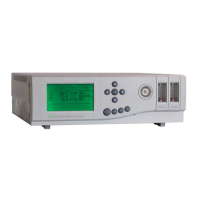2.20
2.11 Calibration gas sample connection
If your analyser has the optional internal auto calibration solenoids then the
appropriate calibration gases must be connected to the instrument at the appropriate
ports on the manifold. If no auto calibration manifold is fitted or the external
autocalibration option is used then the calibration gases should be connected to the
sample gas port by external means. These should be delivered to the xentra at the
same pressure and flow rate as the sample gas.
WARNING
Internal autocal is unsuitable for use with toxic samples.
If toxic samples are present, the maximum pressure to the analyser must be
limited to 5 psig by means of a suitable release system.
Two calibration mixtures are required to perform the low and high calibrations of the
transducers fitted. The analyser software may be configured to specify which of the
two gases should be used as low gas for each transducer. The other will then be
the high gas for that transducer. It is possible for the low calibration gas mixture of
some transducers to function as the high calibration gas for other transducers and
vice versa.
The gas mixtures recommended for calibration of the instrument will depend on the
gas components measured by the transducers fitted to the gas stream and the
measurement ranges of the transducers. The recommended gases are limited by
the long term storage stability of the components of the mixture. Certain gas
mixtures should be avoided as these will not be stable with time. For example gas
mixtures containing O
2
, N
2
and NO are not stable and should not be used.
Table 2.10 shows gas components recommended in the two gas mixtures needed.
Table 2.11 shows the recommended concentration of the gas components in the
mixture. For example, the recommended gas mixtures for a xentra 4900 analyser
fitted with a paramagnetic transducer, NO Gfx transducer and standard sensitivity
CO transducer would be as follows:-
Calibration gas 1
CO 200 vpm
Air Balance
Calibration gas 2
NO 100 vpm
N
2
Balance

